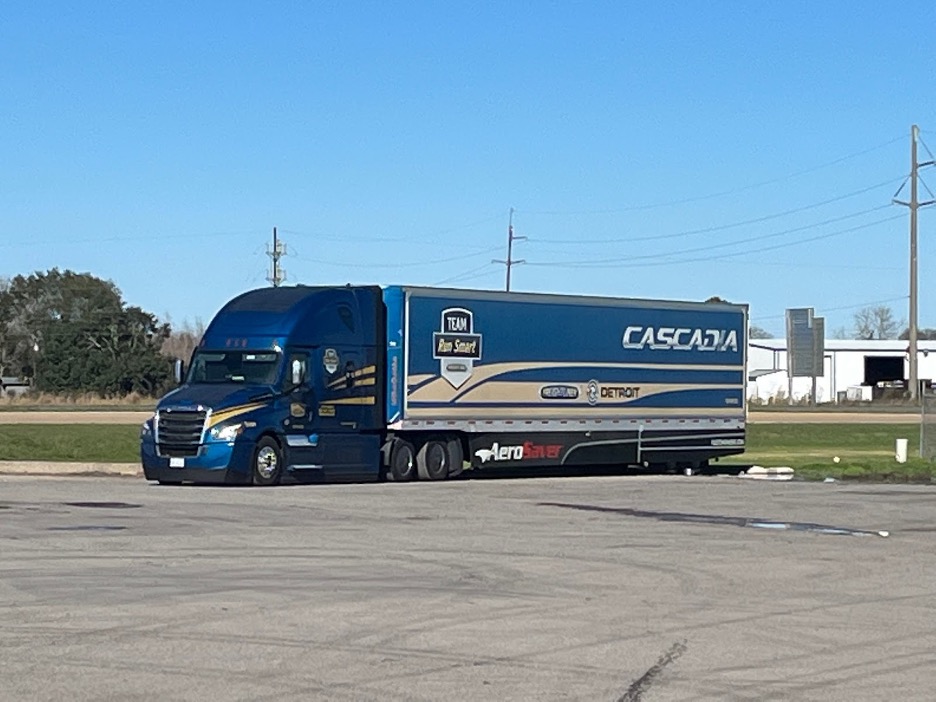.jpg.aspx?lang=en-US&width=500&height=375)
As I write this blog, it’s been one year to the day since my wife Ruth and I picked up our 2022 Freightliner Cascadia at the Cleveland North Carolina truck manufacturing plant. This truck has been a dream in fuel mileage, ride quality, comfort, and amenities.
Let's start with the fuel mileage because that is always the utmost interest with fuel prices, especially at the levels they’ve been for the last year. The lifetime fuel mileage is 10 mpg flat, and the last 90 days have been 10.49 mpg at 123,519 miles. Since Intelligent Powertrain Management has been activated, the fuel mileage has increased to 4/10ths of a mile to the gallon. For a little over 100,000 miles, this truck was operated without Intelligent Powertrain Management, because of the computer chip shortage. My previous Cascadia had an earlier version of IPM. When I heard that they leaped from IPM 6 all the way to IPM 10, I completely understood why. IPM 10 and how it reacts to the terrain, is much more sophisticated than the earlier offerings. On IPM 10 there is an adjustment for upper-speed tolerance, momentum peaks, and low-speed tolerance.
Other features that have been enhanced are the Detroit Assurance Collision Mitigation System. Each generation of these safety systems become more and more sophisticated and are really close to flawless in their operation. Yes, still occasionally, the collision mitigation system can pick up on something that you did not want it to see. It is never really a big deal, and I regularly compare it to walking a dog. The key to properly using a collision mitigation system is to stay a step ahead of it, so that it doesn’t react to anything. When you walk a dog and see something on the sidewalk that you’re sure the dog will react to adversely, you generally restrain the dog before it engages with the threat ahead. It's the same thing with driving a vehicle with collision mitigation. By lightly applying the throttle, or the break of canceling the cruise control, you are taking control of the vehicle much like you would if you took control of a dog with a leash.
Another feature that I enjoy, which is one of the two reasons that led us to name our truck Celeste, is the Merlin Solar Panels, which are mounted on the roof and on the hood of our Cascadia. By having solar power, it has greatly enhanced the operation of the Freightliner dual HVAC system, which operates on battery power instead of idling the engine, or running a Diesel-powered APU for power. So in essence, Celeste is drawing power from the sun to keep us comfortable during our rest time in the truck. The second feature which led to our naming the truck Celeste, is Link's ROI Cabmate Electronically Controlled Cab Suspension. Having the ROI Cabmate suspension system on the cab has taken an already good ride and transformed it into a heavenly ride.
The newest component that we have added to the specifications of our Freightliner Cascadia, is the Hendrickson OPTIMAAX Liftable Pusher Axle. I also have a Hendrickson liftable pusher axle on our trailer. By having these features, it allows me to go anywhere from three axles on the ground, to five axles on the ground. In addition to not having the rolling resistance and tire scrub associated with extra tires on the roadway, there is a weight savings of over 400 lbs. This system not only saves fuel, but also reduces tire wear by lifting axles off the road when they’re not needed. The OPTIMAAX suspension system also can reduce your toll costs where you are charged by the axle.
The feature that we use to lighten up the front of the truck, so as to fully take advantage of the Hendrickson OPTIMAAX liftable pusher axle, is the Hendrickson AIRTEK Air Ride Steer Axle which reduces the tare weight by approximately 160 pounds. I must say, LINK's ROI Cabmate active cab suspension and the Hendrickson AIRTEK steer axle have made a great combination in regards to a comfortable ride.
Last but not least, let's not forget about the weight and fuel savings contribution that the Michelin Wide-Base Single Tires on our truck and trailer add, as well as the contribution to the overall efficiency and ride quality of Celeste. At this point, the steer tires seem to be on target to exceed the 285,000 miles I traveled on my last set of Michelin steer tires on the previous truck. That's like traveling over ten times the circumference of the Earth on the same set of steer tires.
The entire combination of weight and fuel-saving components adds up to our Cascadia having a tare weight of 18,940 lbs with a full tank of fuel, all of my gear, and two persons on board. I think that’s pretty good for a truck equipped with a 72-inch sleeper with two beds, a driver's lounge, and a battery-powered HVAC system. All of Celeste's specifications are listed on the Team Run Smart page under my bio.
The only time Celeste has needed any maintenance was for the scheduled 25,000-mile chassis lubrication, 75,000-mile oil change, and 100,000-mile overhead adjustment on the Detroit DD15. I found out after getting the overhead run at 100,000 miles on the DD15, that it is now the factory recommendation to get the first overhead adjustment done at 500,000 miles.
It's been a great year. From myself, my wife Ruth, our truck Celeste, and the entire team at TRS, we wish you all the best in the year ahead.